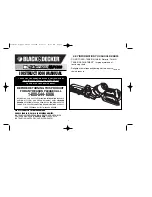
13
CAUTION:
•
Always be sure that the blade will move down to
bevel direction during a bevel cut. Keep hands out
of path of saw blade.
•
During a bevel cut, it may create a condition
whereby the piece cut off will come to rest against
the side of the blade. If the blade is raised while the
blade is still rotating, this piece may be caught by
the blade, causing fragments to be scattered which
is dangerous. The blade should be raised ONLY
after the blade has come to a complete stop.
•
When pressing the handle down, apply pressure
parallel to the blade. If the pressure is not parallel to
the blade during a cut, the angle of the blade might
be shifted and the precision of the cut will be
impaired.
5.
Compound cutting
Compound cutting is the process in which a bevel
angle is made at the same time in which a miter
angle is being cut on a workpiece. Compound cut-
ting can be performed at angle shown in the table.
When performing compound cutting, refer to “Press
cutting”, “Slide cutting”, “Miter cutting” and “Bevel
cut” explanations.
6.
Cutting crown and cove moldings
Crown and cove moldings can be cut on a com-
pound miter saw with the moldings laid flat on the
turn base.
There are two common types of crown moldings
and one type of cove moldings; 52/38° wall angle
crown molding, 45° wall angle crown molding and
45° wall angle cove molding. See illustrations.
There are crown and cove molding joints which are
made to fit “Inside” 90° corners ((1) and (2) in Fig.
A) and “Outside” 90° corners ((3) and (4) in Fig. A).
Measuring
Measure the wall length and adjust workpiece on
table to cut wall contact edge to desired length.
Always make sure that cut workpiece length
at the
back of the workpiece
is the same as wall length.
Adjust cut length for angle of cut. Always use sev-
eral pieces for test cuts to check the saw angles.
When cutting crown and cove moldings, set the
bevel angle and miter angle as indicated in the
table (A) and position the moldings on the top sur-
face of the saw base as indicated in the table (B).
In the case of left bevel cut
1. 52/38° type
crown molding
2. 45° type crown
molding
3. 45° type cove
molding
006393
Miter angle
Bevel angle
Left and Right
45˚
Left
0˚
-
45˚
Right
50˚
Left
0˚
-
40˚
Right
55˚
Left
0˚
-
30˚
Right
57˚
Left
0˚
- 25
˚
52
˚
38
˚
45
˚
45
˚
45
˚
45
˚
1
2
3
001555
1. Inside corner
2. Outside corner
1. Inside corner
2. Outside corner
(1) (2) (3) (4)
1
2
Fig.A
001556
2
(1)
(2)
(1)
(2)
(2)
(1)
(2)
(1)
(1)
(2)
(3)
(4)
1
001557
006361
(1)
(2)
(3)
(4)
Molding
position in
Fig. A
Bevel angle
Miter angle
For outside
corner
For inside
corner
52/38˚ type
45˚ type
Right 31.6˚
45˚ type
Left 33.9˚
Left 30˚
52/38˚ type
Left 31.6˚
Right 31.6˚
Left 35.3˚
Right 35.3˚
Right 35.3˚
Table (A)
006362
Molding
position in
Fig. A
Molding edge against
guide fence
Finished piece
(1)
Ceiling contact edge should
be against guide fence.
(2)
(3)
(4)
Ceiling contact edge should
be against guide fence.
For
outside
corner
Finished piece
will be on the
Left side of
blade.
Finished piece
will be on the
Right side of
blade.
For inside
corner
Wall contact edge should be
against guide fence.
Table (B)
Содержание LS0714FL
Страница 67: ...67 ...














































